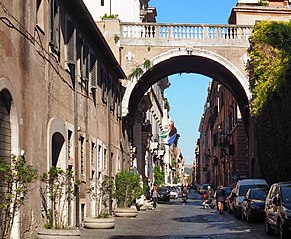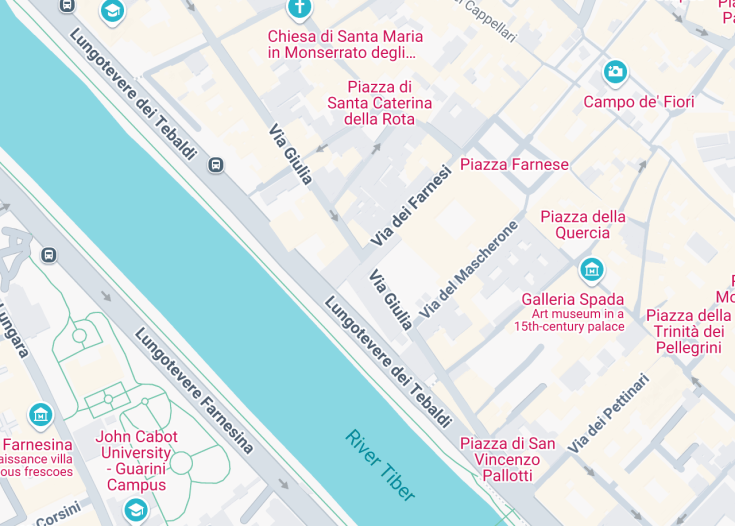The Arco Farnese in Rome is a magnificent architectural feature that reflects the grandeur of Renaissance Italy. Constructed in 1603 as part of Michelangelo’s ambitious plans for a link between Palazzo Farnese and Villa Farnesina, this elegant arch serves as a testament to the artistic vision and historical significance of the Farnese family.
Visitors are encouraged to take a moment to admire the intricate details of the Arco Farnese, especially the ornate decorations that include the emblem of the Farnese family. The best views can be enjoyed from the adjacent streets of Via Giulia.
For an enhanced experience, consider exploring the surrounding area, including historic sites like Palazzo Farnese. This not only provides context to the arch’s significance but allows visitors to appreciate the rich tapestry of Roman history intertwined with the Arco Farnese.
Arco Farnese in Rome (Europe, Italy, Lazio, Rome, Things to Do in Rome, Arco Farnese)
The Arco Farnese is a remarkable architectural feature located along Via Giulia in Rome. This elegant archway, adorned with the lily symbol of the Farnese family, serves as a poignant reminder of the ambitious plans laid out for enhanced connectivity within the city. Once an integral part of a grand design envisioned by the renowned sculptor and architect Michelangelo, the arch represents the only completed segment of what was intended to be the Ponte Farnese, a grand elevated passage connecting Palazzo Farnese with the family’s properties across the Tiber River, particularly Villa Farnesina.
The Arco Farnese exemplifies the Renaissance architectural style, illustrating a fusion of functionalism and aesthetics. With its impressive structure, the arch was designed not only as a practical passage but also as an ornamental gateway, enhancing the visual appeal of the urban landscape. The arch’s commanding presence alongside notable edifices such as the Church of Santa Maria dell’Orazione e Morte forms a striking visual ensemble characteristic of the area, demonstrating the wealth and power of the Farnese family during the Renaissance.
Although the original vision for the passetto was never fully realized due to financial constraints, the arch completed in 1603 remains a testament to the architectural ambition of its time and the unfinished dreams of its creators. Visitors today can appreciate the intricate carvings, its monumental scale, and the historical significance it holds as a part of Rome’s rich tapestry of artistic heritage.
History
16th Century: The Vision
In the 16th century, Pope Paolo III Farnese commissioned Michelangelo to design a structure that would elegantly connect Palazzo Farnese with Villa Farnesina. This project aimed to enhance not only the aristocratic lifestyle of the Farnese family but also the overall aesthetic coherence of their urban estates along the Tiber. Michelangelo’s design envisioned a magnificent elevated walkway that could facilitate safe passage over Via Giulia and the river itself.
Post-Michelangelo Era: Continuation and Challenges
Following Michelangelo’s death, the project was transferred to architects The Vignola and Giacomo della Porta. Despite their efforts, persistent financial troubles haunted the Farnese family, ultimately stalling the construction. The aspiration of a completed Ponte Farnese diminished as budgetary constraints led to the abandonment of the broader project, leaving the Arco Farnese as the singular remnant of a grand scheme.
20th Century: A Commemoration
The Arco Farnese witnessed reinterpretations of its significance throughout the centuries, particularly in the 20th century when a temporary installation was created to honor Michelangelo’s original concept. This event not only revived interest in the history and architectural merit of the arch but also allowed contemporary visitors to engage with a vision that had remained unrealized for nearly five centuries.
Experiences at Arco Farnese in Rome
Visitors exploring the Arco Farnese can enjoy a navigable passage that allows for both admiration of the architectural details and the peaceful atmosphere of Via Giulia. The arch is often frequented by photographers and artists working in the area, drawn to its classic design and serene position amidst bustling Rome. Nearby, the church of Santa Maria dell’Orazione e Morte presents opportunities for further exploration of religious and historical contexts.
Distinctive architectural style observed at the Arco Farnese
The Arco Farnese showcases characteristic elements of the Renaissance style, such as symmetry, proportion, and classical ornamentation. The blending of function with beauty reflects the era’s ideals, inviting passersby to appreciate its grandeur. The arch not only serves a practical purpose but also acts as a canvas exhibiting symbolic motifs linked to the Farnese legacy, allowing visitors to connect with Rome’s rich historical narrative.
General informations
Location
The Arco Farnese, a remarkable surviving element of Michelangelo’s vision, is located at the intersection of Via Giulia in Rome. It stands out near major landmarks such as Palazzo Farnese and the beautiful Tiber River, making it an easy stop for those exploring the area.
Address:
Via Giulia, 185, 00186 Roma RM, ItalyVisiting Information
Access to the Arco Farnese is free of charge, allowing visitors to appreciate this historical structure at their leisure. It is recommended to visit during the early morning or late afternoon for a more serene experience while taking in the architectural details and the surrounding sights.
How to reach Arco Farnese
Car
The Arco Farnese can be conveniently reached by car. There are several parking options nearby, although they may involve a nominal fee.
| Route | Distance | Travel time |
|---|---|---|
| From Fiumicino Airport | 31 miles (50Km) | 45 minutes |
| From Termini Station | 2 miles (3Km) | 10 minutes |
| From Trastevere | 1.5 miles (2.5Km) | 7 minutes |
Public Transport
The Arco Farnese is well-served by public transport, making it an accessible destination within Rome.
| Route | Type | Travel time |
|---|---|---|
| From Termini Station | Metro + Walk | 15 minutes |
| From Piazza Venezia | Bus | 10 minutes |
| From Trastevere Station | Tram + Walk | 20 minutes |
Accessibility and Limitations
The Arco Farnese is generally accessible to visitors, but there are some considerations to keep in mind.
Accessibility
Limitations
- There are no restrooms located immediately nearby.
- Visitation may be limited during local festivals or events.
- It is an open structure and lacks any indoor facilities.
Notes to visitors
- Visitors might want to check local event schedules, as they can impact accessibility to the area.
- It’s advisable to wear comfortable footwear, as the surrounding area is best explored on foot.
- Photography is permitted; however, please be mindful of other visitors.
Common questions
What can I see near Arco Farnese in Rome?
When visiting the Arco Farnese in Rome, you’ll find several notable attractions in close proximity that enhance your experience of this historic area.
Firstly, you can explore Palazzo Farnese, an exquisite 16th-century palace that houses the French Embassy. Its stunning architecture and art make it a must-see.
Right next to the Arco, you will also encounter the Church of Santa Maria dell’Orazione e Morte, known for its unique interior and rich history.
Further along, a short walk will take you to the beautiful Tiber River, where you can enjoy riverside strolls or take in the scenic charm of Rome.
Lastly, don’t miss out on Via Giulia itself, a picturesque street renowned for its Renaissance architecture, making it a wonderful backdrop for photographs.
What is the significance of the Arco Farnese?
The Arco Farnese serves as a symbol of the ambitious architectural vision of the Farnese family and the legacy of Michelangelo.
Commissioned during the 16th century, it was intended to be part of a larger project known as the Passetto Farnese, connecting Palazzo Farnese to the family’s gardens across the Tiber.
Though the full vision was never completed, and it remains just the initial phase, the arch itself is a testament to Renaissance architectural grandeur and ingenuity.
The intricate decorations showcasing the family’s symbols, like the lily, add to its historical and cultural significance, making it an important landmark in Rome.
Can I take photos at Arco Farnese?
Absolutely! The Arco Farnese is a picturesque site that offers great opportunities for photography.
The arch, with its elegant design and historical backdrop, provides a unique aesthetic which is particularly appealing to those interested in architecture and history.
Whether you wish to capture the intricate details of the arch itself or the lively surroundings of Via Giulia, you will find plenty of captivating photo opportunities.
Just be mindful of pedestrian traffic and always respect the area, especially if you are shooting at busier times.
What are some tips for visiting Arco Farnese?
Visiting the Arco Farnese can be an enjoyable experience, especially with some useful tips to enhance your trip.
Firstly, plan your visit in the early morning or late afternoon to avoid crowds and capture the best lighting for photos.
Bring comfortable walking shoes as you’ll likely want to wander around Via Giulia and explore nearby attractions, which can involve a fair amount of walking.
While exploring, take the time to admire the nearby architecture and street art that often adorns this historic area.
Finally, consider visiting on a weekday if you prefer a quieter experience, as weekends can often draw in more tourists.
Is there dining available near Arco Farnese?
Yes, there are several dining options available near Arco Farnese for visitors looking to enjoy a meal or a snack.
A variety of trattorias and cafés line Via Giulia and its surrounding streets, offering a mix of traditional Roman cuisine and casual dining experiences.
Popular local dishes include pasta all’amatriciana and suppli, which you will find on many menus.
Additionally, there are gelato shops nearby, perfect for a refreshing treat after your exploration of the area.
Be sure to check out the outdoor seating options for a pleasant dining experience with a view of this charming Roman arch.

Is the Arco Farnese in Rome Worth Visiting?
The Arco Farnese in Rome is definitely worth a visit for those interested in history and architecture. This elegant structure, completed in 1603, represents the only portion of what was supposed to be a magnificent overpass linking Palazzo Farnese and Villa Farnesina across the Tiber River. Although the grand vision by Michelangelo was never fully realized, the arch beautifully showcases the artistic legacy of the Farnese family and stands as a reminder of the ambitious projects of the Renaissance. Its design features the iconic lily, symbolizing the Farnese, and offers a glimpse into Rome’s rich history. Visitors will appreciate the architectural elegance and the stories that lie behind its construction, making it a fascinating stop in the vibrant streets of Rome.









